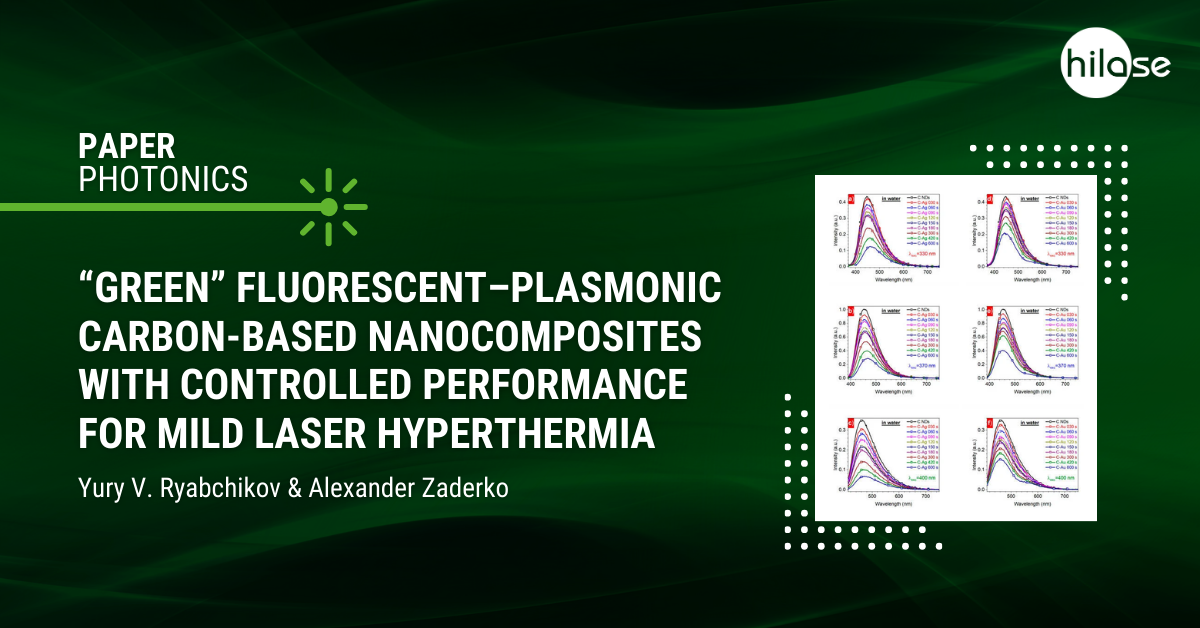Yury V. Ryabchikov, senior researcher in the area of Mid-IR and Bioapplications at the HiLASE Centre, published a research paper in collaboration with Alexander Zaderko from Taras Shevchenko National University in Kyiv, Ukraine. The study titled “Green” Fluorescent–Plasmonic Carbon-Based Nanocomposites with Controlled Performance for Mild Laser Hyperthermia can be found in the Photonics journal.

Fluorescent carbon nanodots are a promising nanomaterial for different applications in biophotonics, sensing and optical nanothermometry fields due to their strong fluorescence properties. However, their multi-modal applications are considerably limited, requiring the use of several nanoagents that could solve different tasks simultaneously. In this paper, we report the first experimental results on a facile “green” laser-based synthesis of multi-modal carbon–metallic nanocomposites with tuned optical performance. This simple approach leads to the appearance of finely controlled plasmonic properties in carbon-based nanocomposites whose spectral position is adapted by using an appropriate material. Thus, longer laser ablation provokes 29-fold increase in the absorption intensity of carbon–gold nanocomposites due to the increase in the metal content from 13% (30 s) to 53% (600 s). Despite strong plasmonic properties, the metal presence results in the quenching of the carbon nanostructures’ fluorescence (2.4-fold for C-Au NCs and 3.6-fold for C-Ag NCs for 600 s ablation time). Plasmonic nanocomposites with variable metal content reveal a ~3-fold increase in the laser-to-heat conversion efficiency of carbon nanodots matching the temperature range for mild hyperthermia applications. The findings presented demonstrate a facile approach to expanding the properties of chemically prepared semiconductor nanostructures due to the formation of novel semiconductor–metallic nanocomposites using a “green” approach. Together with the ease in control of their performance, it can considerably increase the impact of semiconductor nanomaterials in various photonic, plasmonic and biomedical applications.
Have a look at other most recent papers of the Scientific Laser Applications department:
- Dual-wavelength femtosecond laser-induced single-shot damage and ablation of silicon | Alexander V. Bulgakov, Juraj Sládek, Jan Hrabovský, Inam Mirza, Wladimir Marine, Nadezhda M. Bulgakova
- Non-thermal regimes of laser annealing of semiconductor nanostructures: crystallization without melting | Inam Mirza, Alexander V. Bulgakov, Hanna Sopha, Sergey V. Starinskiy, Hana Turčičová, Ondřej Novák, Jiří Mužík, Martin Smrž, Vladimir A. Volodin, Tomáš Mocek, Jan M. Macak, Nadezhda M. Bulgakova
- From Localized Laser Energy Absorption to Absorption Delocalization at Volumetric Glass Modification with Gaussian and Doughnut-Shaped Pulses | Martin Zukerstein, Vladimir P. Zhukov and Nadezhda M. Bulgakova in collaboration with Yuri P. Meshcheryakov








